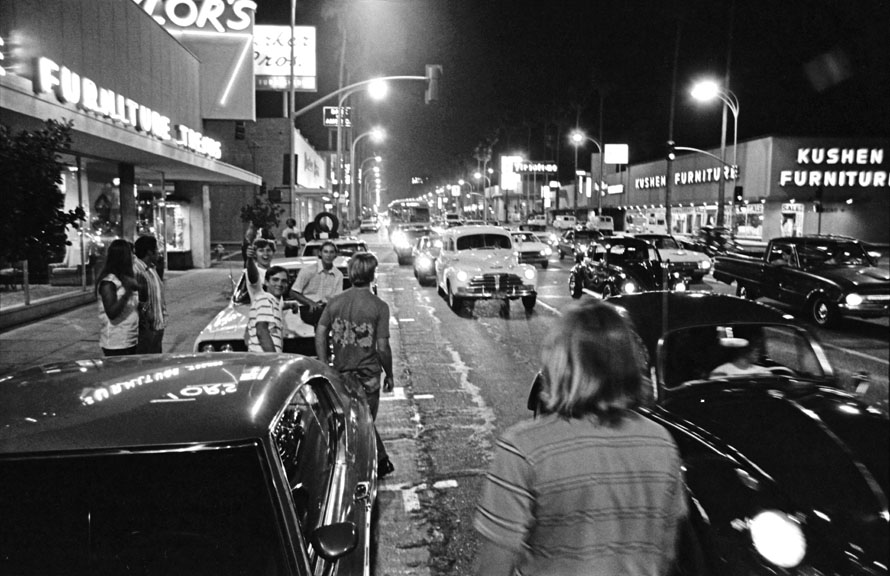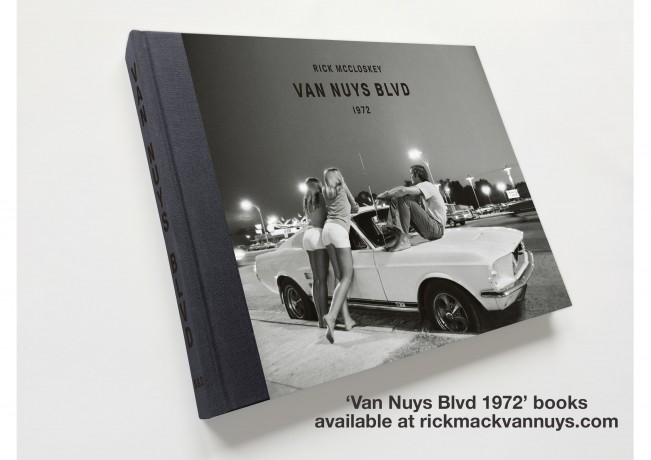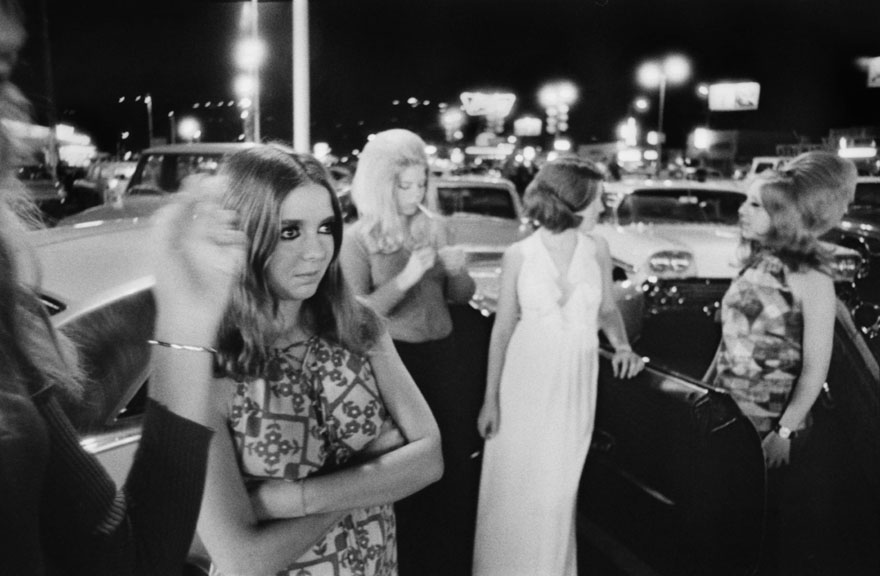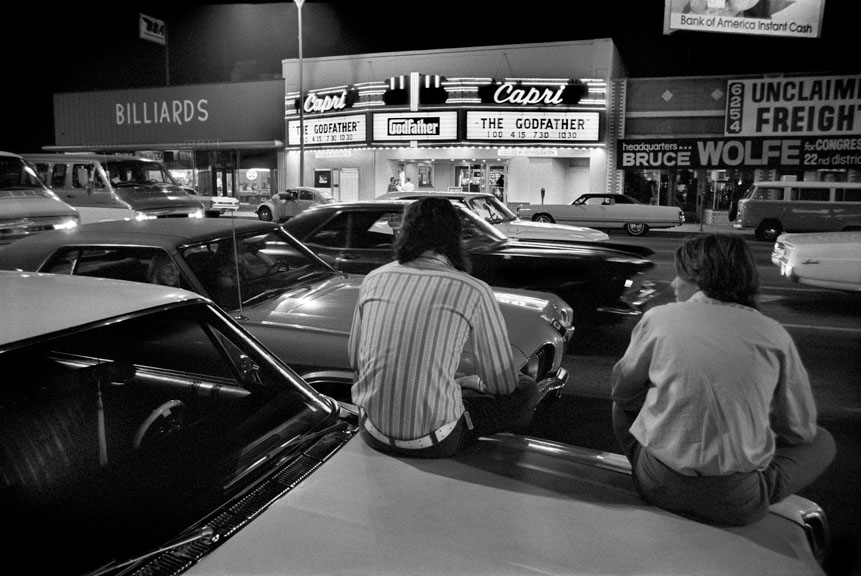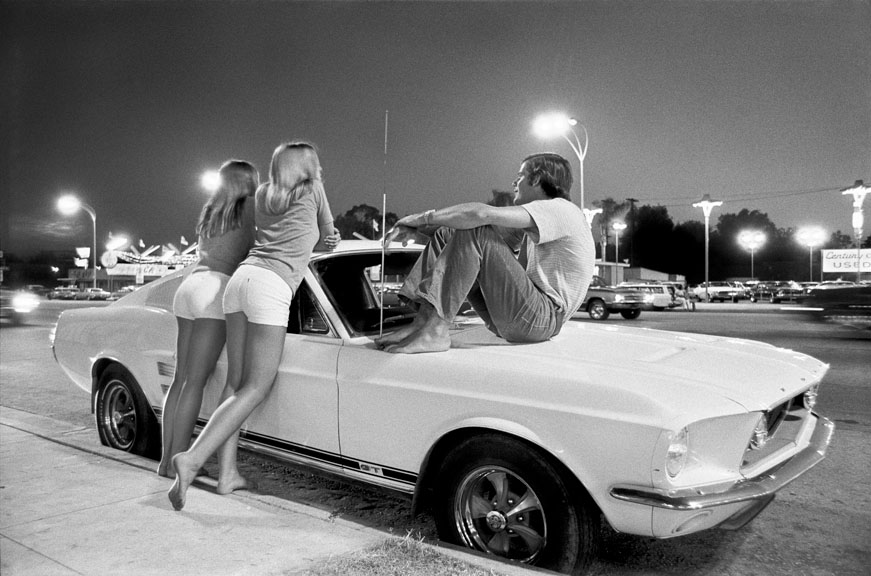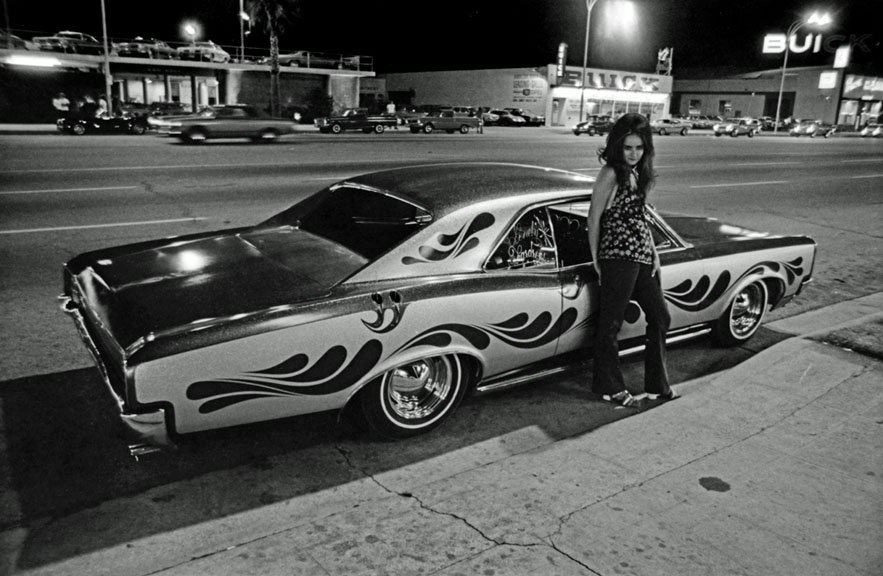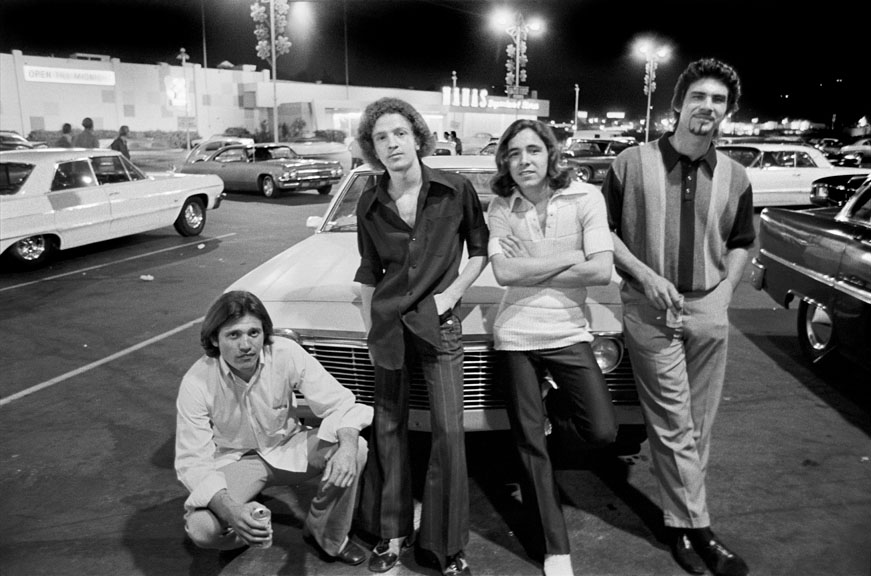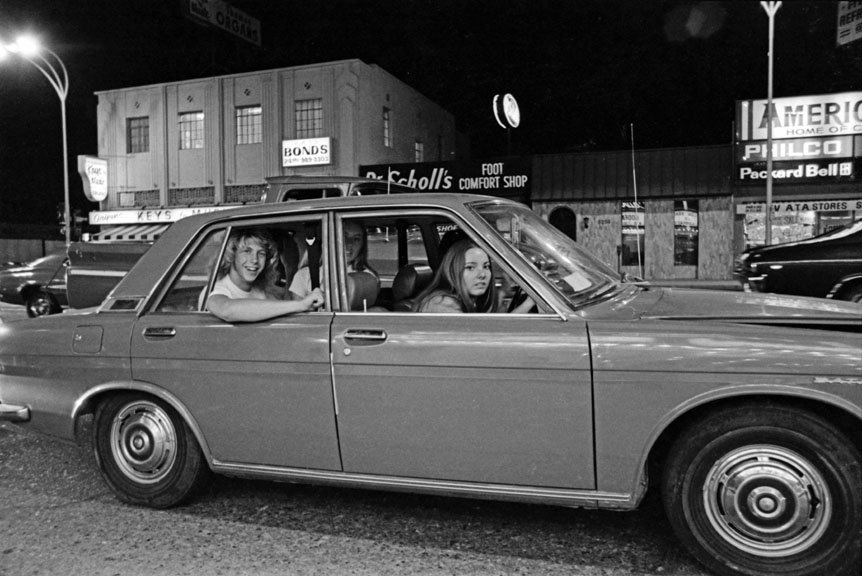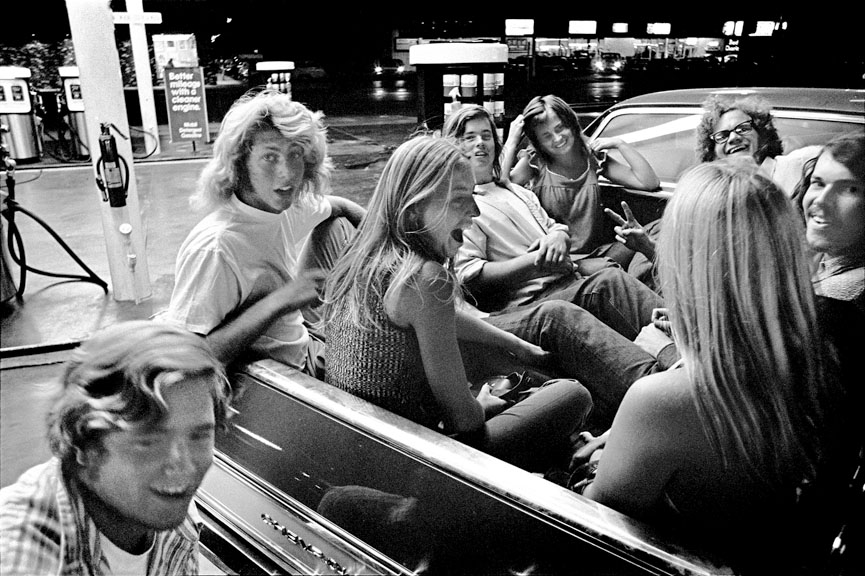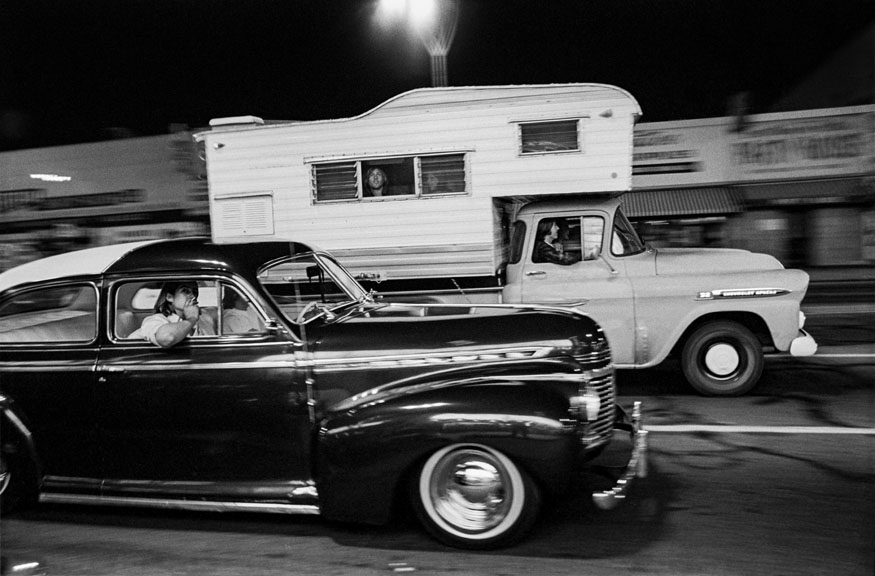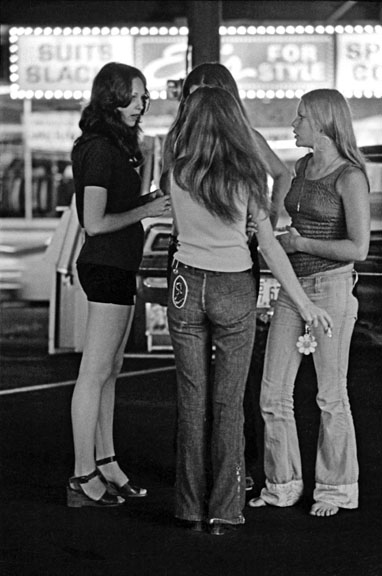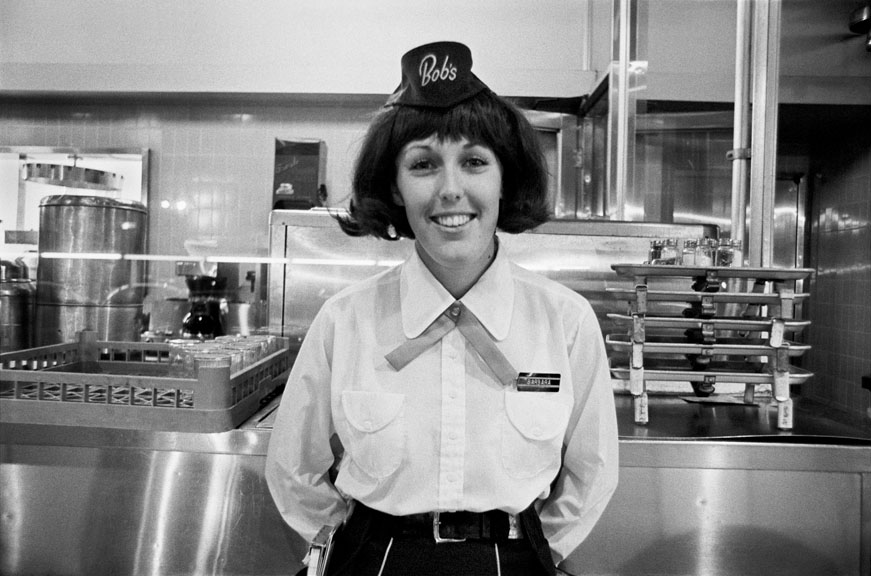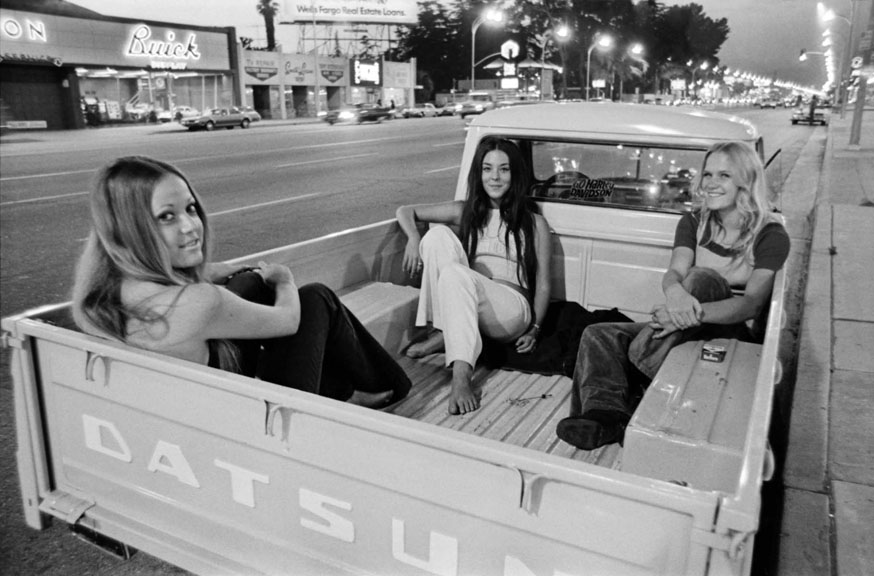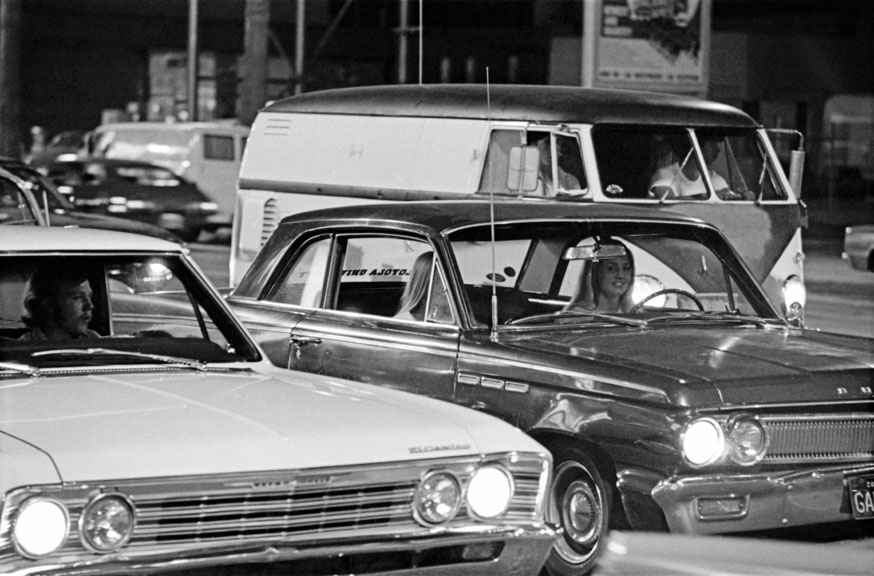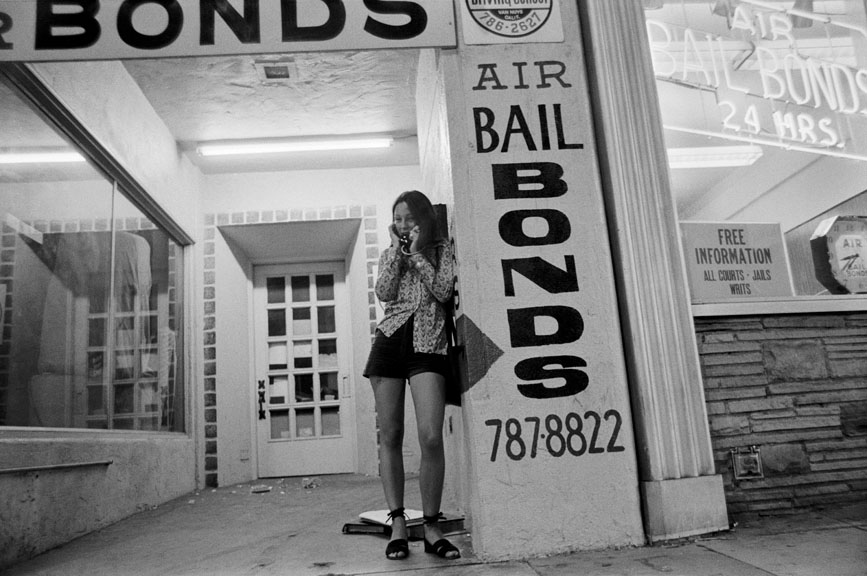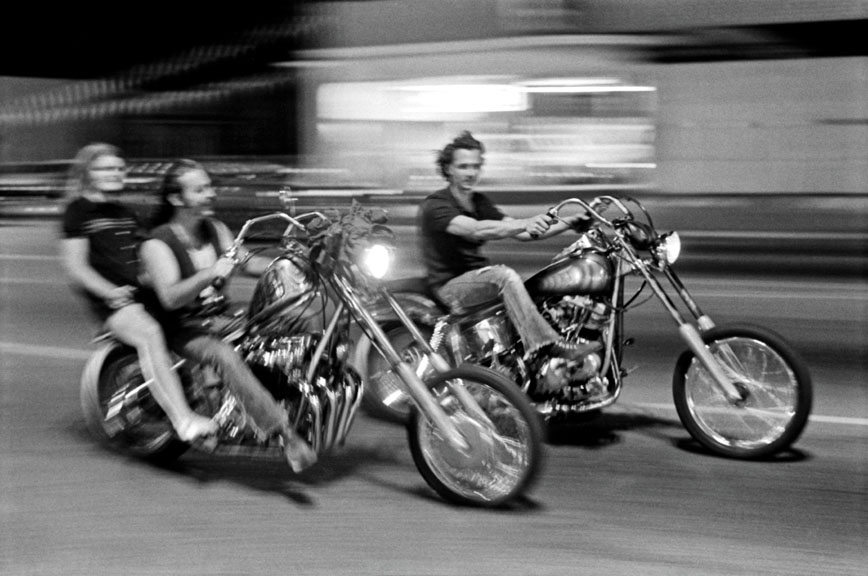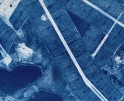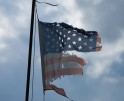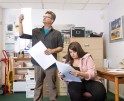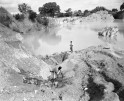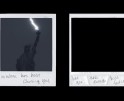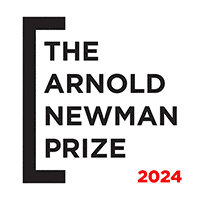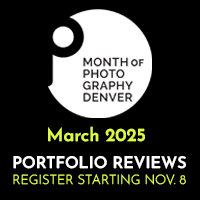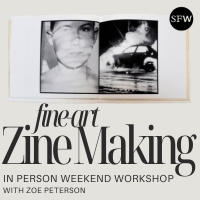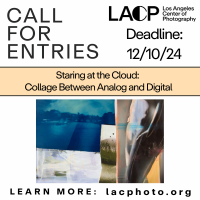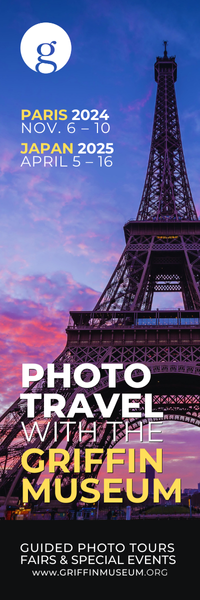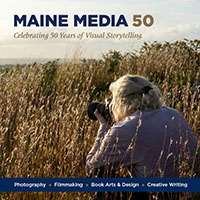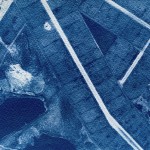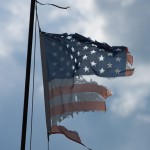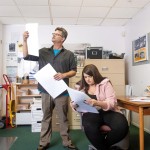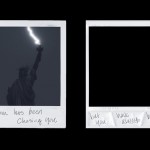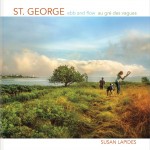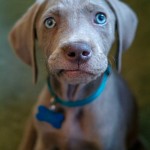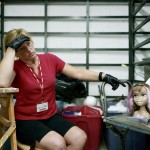I LOVE L.A.: Rick McCloskey: Van Nuys Blvd. 1972
The idea of cruising is/was a national past time in small towns and big cities. I well remember the cool night air as a carload of girlfriends and I drove down Sunset Strip night after night in someone’s family station wagon, air thick with adolescent perspiration and teen spirit pheromones, looking for something not quite tangible. The streets were crowded in front of venues such as the Roxy and the Whiskey a Go Go, and we felt a thrill to be out of our bedrooms and watching the action from the safety of our car, trying to look as cool as a 16 year olds can look.
Los Angeles has always been about car culture and what better project to go back in time and experience those nights of freedom and friends, laughing and looking for love (or trouble) than Rick McCloskey’s series from 1972, Van Nuys Blvd. Filmmaker Paul Thomas Anderson celebrated this world in his movie, Licorice Pizza. In the summer of 1972, Rick McCloskey went to Van Nuys Boulevard, near his parents’ home and for three months, every Wednesday and sometimes Friday and Saturday evenings photographed the action.
In 2020, McCloskey released a monograph, published by Sturm & Drang. McCloskey sells signed books. People can contact him directly at rick@rickmack.com to order books. He would need their email and mailing address to send them a PayPal invoice.
A Word About Me and ‘The Valley’
In June of 1957, my family moved from a cramped, 1920s neighborhood in West Hollywood to a new, spacious 1950s neighborhood in Sherman Oaks in the San Fernando Valley. On Vista del Monte, our wide street, all of the house lots were surprisingly expansive, and remnant walnut trees still graced many of the yards around the valley rambler homes on our new block. There were still peach orchards, a whole walnut grove remained behind our back fence, beyond which ran Van Nuys Boulevard. Fragrant orange groves grew nearby. I had just turned eleven years of age. At the time, and for a kid, it was a veritable paradise. The days were carefree, and there was no doubt, we were experiencing the American dream.
Change was coming.
I finished sixth grade at Kester Avenue Elementary, moved on to Van Nuys Junior High School, both schools were within walking distance. There was a shortcut through the peach orchard across Magnolia Boulevard to the junior high. Most days we went that way, but sometimes we walked the long way down Van Nuys Boulevard past Bob’s Big Boy, then down Clarke Street to school. Bob’s had great chocolate donuts for a nickel each. Those delicious donuts were well worth the extra time and distance. Life was good.
Consider for a moment, at the time, one impossible to miss constant was the car cruising culture along Van Nuys Boulevard, and the Bob’s Big Boy Drive-in was also the main hub of that culture, day and night. No matter where you lived, those of us who grew up in the valley, were destined to become part of that cruising culture during our teenage years. Much the same could be said of teenagers in every town and city across America, as every town had its own cruise strip. Cars and cruising were a formative experience for the better part of three generations, and for me in particular. Was this also part of the American dream?
Again, change was coming, but who knew?
On to Van Nuys High School, 50th year graduating class, 1964. Then on to classes at both LA Pierce College, and also LA Valley College, some at night, while working a full-time day job at the ‘Valley News and Greensheet,’ and later at Musso-Clifford Advertising near LAX. In 1968, I transferred to California State University at Northridge, then known as Valley State College, and enrolled in the History Department, but soon found myself in their very fine Department of Photography. Three years later, I had completed the necessary classes for my degree in History and a minor degree in Art, specializing in photography.
In the spring of 1972, on a tip from a friend, who had recently started work at, the now legendary, ‘Corky’s Restaurant’ on Van Nuys Boulevard, I set out to document the renewed and vibrant cruising scene on that boulevard. The photographs from that summer are presented in this visual essay. The project was a perfect fit for me.
Looking back to 1972, few of us expected the ‘cruising’ scene, along with the young people’s spontaneous use of the public space on the main streets and boulevards across America, to all but disappear by the end of the 1970s. Neither am I able to digest just how quickly the wide-open spaces, so prevalent in the San Fernando Valley in the late 1950s, were entirely filled with homes, apartments and strip malls by the time I was documenting the nightlife on Van Nuys Boulevard in 1972. Barely 15 years had passed.
The Van Nuys photographs now stand as a unique ‘time capsule’ of vanished American life. – Rick McCloskey
Van Nuys Boulevard: American Car Culture At Its Vibrant Best
Wednesday night was Cruise Night in the San Fernando Valley. The Valley is a part of greater Los Angeles, and Van Nuys Boulevard, in The Valley, was the place to cruise. The boulevard teemed with kids and cars from all over Southern California on Friday and Saturday nights as well, but Wednesday night was the big night for cruising. The boulevard ran straight and true from its southern beginning at Ventura Boulevard in Sherman Oaks all the way north through Panorama City and beyond. If you were young during the 1950s, the 1960s, or the 1970s, and you owned or had access to a car, or a motorcycle, Van Nuys Boulevard was the place to be in the evenings. It was a terrific place to both see and be seen in and with your ride.
Allow me to take a moment to present a very quick history of the city of Van Nuys and the San Fernando Valley. The Valley is, and was, extremely large and arid, very hot in the summer, and mainly consisted of cattle ranch lands during the latter part of the 19th century. Southern California began to grow rapidly with the coming of the 20th Century, and the city of Van Nuys was established in 1911. The entire San Fernando Valley was annexed by Los Angeles in 1915. The brand new Owens Valley Aqueduct was completed at about the same time, and the annexation by Los Angeles allowed for plentiful water to be supplied to The Valley. Orange orchards, walnut orchards—and even grazing sheep in the West Valley hills, became the norm and proliferated through World War II. The city of Van Nuys grew as well, thanks in part to the extension of the Pacific Electric Railway bringing a commuter line from downtown Los Angeles directly to Van Nuys. California enjoyed a tremendous boom in growth during and after WWII, and The Valley became the target of massive residential development for the burgeoning Baby Boom families. It took less than twenty-five years to completely fill every vacant piece of land in the entire San Fernando Valley with what became known as tract homes.
By the early 1950s, Van Nuys Boulevard had already become a central gathering place, a destination for mobile young people with cars and motorcycles. These were good economic times in the USA. Americans were benefitting from being, for the most part, the only industrial nation still in business after the war. This newly found economic success after ten years of economic depression, followed by five years of war, allowed for adult Americans to finally trade in their aging 1920s and 1930s automobiles for brand new cars. This in turn delivered millions of often very used cars to the market place, inexpensive cars that were readily scooped up by American teenagers eager to become mobile. In the hands of their new owners, many of these cars were, to use the vernacular of the times, souped-up, became hotrods, and soon decorated the evening scene on many boulevards in towns and cities across America. Van Nuys Boulevard was at the apex.
By 1951, Van Nuys had become a busy, prosperous city, and Van Nuys Boulevard had become such a successful destination that the now-famous restaurateur, Bob Wian, opened a brand new, iconic, Bob’s Big Boy Drive-In Restaurant on the boulevard. The 1950s cutting-edge, Coffee Shop Modern styled restaurant was located just south of Burbank Boulevard at the corner of Clark Street. An immediate hit, Bob’s became the center attraction of the pulsing boulevard. For nearly three decades into the future, long streams of automobiles lined up, their occupants waiting for the chance to park in one of the ‘drive-in’ stalls in the rear of Bob’s for car hop service. Car hops brought the food right to your car, and set up special trays that attached either to your steering wheel or to the door of your car. Of course inside sit-down service was available as well for milk shakes, french fries and, what was soon to be, the nationally famous, double-decker, Big Boy Hamburgers.
Hotrods modified from American cars of the 20s, 30s, and 40s ruled the boulevard for the first half of the 50s, but modern, ever more powerful, automobiles began to appear on the street in the second half of the decade—mostly borrowed from parents. By the end of the 1950s, many of the now famous mid-fifties rides were transferred as used cars into the loving hands of young people all over the USA. These new automobiles became the rides of choice for many teenagers, with the older hotrods starting to thin out. Van Nuys Boulevard was where you would see them and their young owners cruising endlessly on Wednesday, Friday, and Saturday nights. Gasoline was very inexpensive making continuous driving, cruising, economically possible—even with high-performance, gas-guzzling engines.
American teenagers of the Baby Boom generation reached the age where they could drive with the coming of the 1960s. Cruising action on Van Nuys Boulevard, and streets all over the USA, mushroomed. The automobile industry recognized the great opportunity for financial reward and soon began designing and building very cool cars aimed specifically at the teenage market. The Ford Mustang was the first to roll off the assembly lines in 1964, and it was followed by Chevrolet ‘mid-sized’ performance cars like the ‘Chevelle,’ the Pontiac GTO, and the Camaro.
Many of these ‘Pony Cars’ and ‘Muscle Cars’ were actually produced at the huge Chevrolet assembly plant located on Van Nuys Boulevard in North Van Nuys. The plant ran three shifts, 24 hours a day, for more than a decade. Good jobs were another product of the great Chevrolet assembly plant, jobs that made possible the purchase of the wonderful cars now frequenting Van Nuys Boulevard.
Times were good, gas was cheap, and the boulevard hummed with life. Even the Vietnam War barely slowed down the action. By 1972, the year I went back to Van Nuys to shoot my series of photographs, the culture on the boulevard had become a representation of divergent lifestyles, automobiles—used and new—and very different looks and styles. There were ‘tribes’ of van kids—surfers mostly—low-riders, muscle cars, street racers, Volkswagen owners, and many more. The idea of ‘retro’ had arrived as well, with some young people emulating the look and style of the 1950s, the age of Brylcreem—‘grease’ for your hair. In my photographs, I set about portraying the young people, their cars, and the iconic background settings—and I tried to capture images in that order of importance.
Little did I suspect during the summer of 1972, that cruising would very much come to an end within a few years. My photographs, my ‘art project,’ would become more a part of a historical record than a graphic account of an ongoing contemporary activity. The ‘Oil Crises’ in the fall of 1973, and the commensurate rise in gasoline prices, coupled with ever-increasing complaints from the business community, resulted in a police clamp-down on cruising and the night time activity of young people on Van Nuys Boulevard. Indeed, the same thing at first dampened the cruising culture on boulevards in many communities across America, and brought an end to this pastime by the early 1980s. These photographic images are what we have left. Please enjoy!
Technical Information:
All images were made with a hand-held 35mm camera using Tri-X black and white film. I generally pushed the development of the film to reflect an effective ASA of 800. Since I worked with only available light at night, long exposures were the norm, and more than usual camera movement resulted in many images showing some softness of focus. These images clearly have their own ‘feel,’ and their own ‘mood.’ Traditional darkroom printing of these images was problematic due to the garish and contrasting light. I have now digitized a selection, and moved to digital printing as well. These modern processes have allowed for much better final presentations of these photographs.
In revisiting this work decades later, what have you learned?
I was deeply immersed in shooting these images in the summer of 1972, selecting and printing them through 1973 and 1974, which culminated in a gallery show at CSUN in 1974.
My time in Los Angeles came to and end shortly thereafter in September of 1974 when I moved to Maui, Hawaii, where I lived until September of 1991. My Van Nuys images, all the negatives, went into storage. I didn’t once look at any of them for almost four decades. After a brief stint living in Costa Mesa, I moved to Washington State in 1993.
Then by chance—and the internet—I reconnected with Kent Bash, an artist, original Van Nuys enthusiast, and old friend from my time in The Valley. We discussed at length the cruising days and the loss of that culture. I set about retrieving the Van Nuys negatives, it took a while to find them, and began the process of viewing, and re-evaluating the series from what now amounted to a historic perspective. Fortunately, the negatives had been stored correctly, and they were still in decent condition. Many months were spent making choices as to which images were worth scanning and digitizing. A forgotten world emerged. I found new insights into many images that I had originally overlooked. Wonderful discoveries of a world and lifestyle that had essentially vanished. Actually, it took several years to select and digitize all of the Van Nuys images in the current collection, a little over 1000 in all, and I see each and every one differently today than I did fifty years ago. New details appear constantly when looking at these images.
One of my main takeaways from the re-emergence and study of these images is just how fleeting places, cultural pursuits—and especially people can be. I do wish that I had taken the time to photograph more of the buildings, so many of which are completely gone now. So much can change in 50 years, nearly three generations.
Who would have thought that the Bob’s Big Boy Restaurant on Van Nuys Boulevard would have disappeared barely 20 years after I shot these photographs?
How does the city inform your work?
I am a direct product of ’the city.’ I was born in Hollywood in the mid 1940s, when Hollywood was the motion picture cultural center of the world, and yet, it was already beginning to wear thin. The city already was old, and the film studios had dispersed to Universal City, Warner Brothers, Culver City, and many of the great and powerful celebrities had moved, or were moving, ‘out west’ to Beverly Hills, Brentwood, Bel Air and, of course, ’The Valley.’
Which brings me to the observation that, when we moved from the old city, West Hollywood, to The Valley in 1957, we were moving to only a partial city. Vast areas of the San Fernando Valley were still open, often agricultural—remembering the orange orchards— and undeveloped. As I grew up, I watched the relentless march of development, the filling in of very piece of open valley land until it was all solid city by the early 1970s. Yes, at the time, it seemed we were part of ’the cutting edge’ of the new America, but only in retrospect is there a sadness at realizing what was lost in the process. It is hard to not be torn between the open spaces of my childhood, and the vibrant city life which followed—including the car culture depicted in my images, of my teen and twenty-something years.
What do you love about Los Angeles?
Perhaps one could say, Los Angeles is a city that is constantly reinventing itself. Each time one leaves for a time and then returns, the city is different.
Are you working on a new project?
Although I still shoot, at this point in my life I’m working at assembling collections of retrospective projects from my time in Hawaii, and my time in Washington. No small task.
Finally, describe your perfect LA Day.
Orange blossoms. Can I once again smell orange blossoms?
Posts on Lenscratch may not be reproduced without the permission of the Lenscratch staff and the photographer.
Recommended
-
Kari Varner: Blueprints for Slaughter and GroundworkNovember 14th, 2024
-
Jason Lindsey: FRAYED DREAMS UNDER STARS AND STRIPESNovember 12th, 2024
-
New England Portfolio Review: Ann Hermes: Local NewsroomsOctober 24th, 2024
-
Joe Reynolds in Conversation with Douglas BreaultOctober 7th, 2024
-
Melissa Grace Kreider: i will bite the hand that feedsSeptember 25th, 2024

